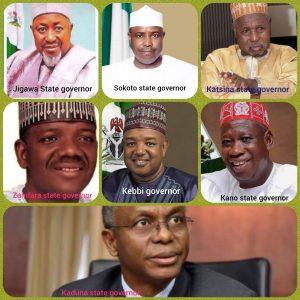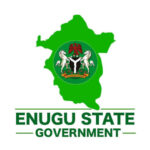
Hemmed in by bandits, Aminu Masari strives on..

The times have really not been kind to Katsina State; not since the time of YarAdua, its governor in the era of President Olusegun Obasanjo. While Masari, who was Speaker of the House of Representatives then did not do badly, his time as governor, to say the least, has been plagued by high rate of crime in the state. His seeming helplessness in the face of it all and the singular fact that he happens to be the governor of the presidents native state amplifies the dire straits the state has found itself in.
It is the new theatre of war in the northwest.
Education
Governor Masari, in a bid to restore the states education sector back to normalcy and past glory, has been implementing the recommendations of the Restoration Agenda committees he created to critically examine the sector and recommend strategies solutions and programmes of action by the APC government before the party emerged victorious in the 2015 polls.
The governor has proved his worth in the current political dispensation in the country. He has gone an extra mile to engage outstanding scholars first late Prof Sadiyya Abdullahi Faskari and her successor Dr. Badamasi Lawal Charanchi to translate his lofty dreams into reality in the education sector.
The mode of approach he adopted to salvage the sector ushered in a new dawn in the construction of new facilities, rehabilitation and upgrading of dilapidated structures-cum provision of learning and teaching materials, as well as boosting the morale of teachers.
Knowing that success in the education sector to a great extent depends on teachers, the Msarai administration moved to recruit over 2600 qualified persons into the main stream of the teaching profession in the state and the attention accorded to development of the teachers intellectual standard through in-service training and seminars while their welfare got the desired attention as salaries, pensions and gratuities are paid as promptly as possible.
Also, the state government introduced loans for teachers in form of motor cycles (among others) and offered public buildings to some of them on rent-free basis
In an effort to increase the number of Katsina state students enrolled in various institutions of higher learning, the governor recently approved the sum of N444,743,100.00 for the payment of WAEC, NECO, NABTEB and NBAIS registration fees for 36,941 students that qualified.
This, is in addition to the sum of N60,175,500.00 earlier released by the state government for the payment of female teachers trainee special scholarship scheme for NCE I, II and III students.
In his quest to improve the standard of the state government owned tertiary institutions, the governor approved the recruitment of both academic and non-academic staff for Isa Kaita College of education Dutsin-Ma.
Considering the present security challenges confronting the nation, particularly in boarding schools, the state government under the watch of Masari also approved the employment of 1,000 watchmen for all the secondary schools across the state to safeguard the students.
Today, beyond this reform, the administration developed a mechanism to address the dearth of manpower in the educational sector through the recruitment drive targeting no fewer than 2,000 additional teachers for both primary and secondary schools in the state.
In December 2017, the administration disbursed the sum of N80 million as refunds for candidates whose payments of WAEC and NECO examination fees had been previously initiated, the intervention, according to government, was targeted at candidates with at least five credits and above.
One of the most critical policy gaps which this unprecedented feat can solve, is the recurring and often embarrassing issue of girl-child enrolment.
According to a survey by the Federal Ministry of Education, Katsina State is third among the states with lowest girl enrolment in school. This gross imbalance manifests more in a larger social problem of exposure of girl-child into early economic activities and other engagements alternative to pursuing education.
The Masari-led administration conceived of more scientific approach to tackling the problem by reviewing the institutional framework, converting all girls secondary schools in the state into boarding institutions.
It has been a considered opinion of many educationalists in the state that, this is one sure footing in addressing the gap which has placed the state on a notorious position in the national education index scale.
The critical issue of staff motivation and welfare cannot be treated in isolation regarding the enhancement of capacity of students-to-teacher ratio, as well as the disengagement and consequent disenchantment from service and the associated trauma of unpaid retirement benefits.
In Katsina, the story is different, as there are more indicators showing that, the overall decline in the priority accorded welfare of teachers in the state is being steadily reversed by Masari.
In order to attend to the envisaged and planned phased-development of the state-owned Umaru Musa YarAdua University, plans have reached advanced stage for the establishment of a teaching hospital for the Faculty of Medical Sciences. With the take-off, the faculty will offer programmes leading to the award of degrees in the fields of medicine, human anatomy, physiology and community medicine.
Similarly, the administration has also approved the establishment of the Faculty of Agriculture at the old Agricultural Training Centre at Layin Minista in Malumfashi local government area to keep pace with the development plan of the university.
In line with what is obtainable in other universities of the country, the state government is in the process of amending the laws of the university in order to domesticate the elongation of retirement age for academic and non-academic staff to 70 years and 65 years, respectively.
These gestures have now provided a serene environment for objective teaching and learning as opposed to the usual dilapidated structures he met in various schools in the state when he came on board as governor. This has left even hardcore critics with no options than to give Masari kudos for achieving a rare feat in that direction.
Despite these numerous achievements, Masari needs to provide additional infrastructural facilities at both primary and secondary schools across the state, payment of WAEC and NECO school fees for the secondary schools students in the state, as well as improve the welfare package for teachers.
Over 300 primary schools were renovated, additional 400 classes were constructed and 1000 classes were renovated. Almost 300 stores/offices were renovated, 70 toilets were newly constructed, 183 Annex primary schools were created, 2 primary schools were upgraded to a storey-building, 15,162 metal desks and chairs were provided for pupils, 893 furniture for teachers, 3,755 plastic tables and chairs were for nursery schools. Teaching and learning materials worth #662,000,000 were procured and distributed to 2,218 primary schools, 5000 teaching staff and 2,336 of S power and N power staff were employed to add to the strength of existing staff. Aside numerous interventions in the tertiary education sub-sector, in the area of scholarship payment, the state government had paid a whopping sum of ₦ 1,045,446,740 to 82,346 students for 2015/2016 and 2016/2017 session of the state indigenes, as the agency is set to pay soonest the outstanding fresh students.
Agriculture
Agriculture achieved greatest milestone in the journey of restoration agenda. The movement from crude to technologically advanced agricultural system witnessed rapid impact. Timely distribution and subsidisation of fertiliser and other agro-allied, rehabilitation and construction of new grain stores, rehabilitation and reconstruction of new dams for dry season irrigation farming.
In detail, 94,360 metric tons of both NPK and Urea were supplied to the state between 2015 and 2018, as about 56,000MTS are already in the store for the 2018 farming season. Over 25 irrigation schemes were renovated and upgraded. Effective Veterinary services ranging from mass deworming of livestock across the state, drugs revolving scheme, control of animal parasite, disease and state-wide animal vaccination, rehabilitation of Kofar Kwaya Veterinary Clinic.
Health
The state government embarked on total upgrade and equipping the state owned medical facilities together with procurement of health workers. The state government in the last 3years had remodeled the government hospitals Katsina, Daura, Funtua, Kankiya, Jibia, Musawa, Baure, Malufashi, renovated burnt staff quarters of Government Hospital Malumfashi, School of Nursing Katsina and School of Midwifery Malumfashi, besides equipping them with requisite personnel and modern health care facilities.
Infrastructure
More than 443kilometres of road have been constructed in the rural areas; Marabar Sayaya-Sayaya 24km, Gora-Makauraci-Mallamawa 40km, Kankara-zango-dan sabau 24km, Musawa-Gin gin-Tabanni 19km, Dayi-Tuge-Gangule-Gundawa 28km, T/Iya-Maska-Dandume 37km and lots more that are ongoing, besides the maintenance and asphalting by the state-owned Road Maintenance Agency (KASROMA).
Housing
The state government has constructed hundreds of affordable housing units to the benefit of the Katsinawa through public private partnership (PPP) to ameliorate the 1,000,000 housing deficit in the state. Also, the Department of Power and Energy, directly under the governor’s office, had provided for consequential and significant rural electrification project in more than 182 rural areas across the 34 LGAs, besides the proposed 34 rural electrification exercise for 2018. A number of urban transformer installations in the cities.
The government has made tremendous effort in managing emergency cases through the State Emergency Management Agency (SEMA) where 88 per cent of the reported cases were beneficiaries of relief assistance building materials, foodstuff, clothing, house hold materials and cash to the affected persons while embarking on regular sensitisation campaigns and public enlightenment on emergency preparedness and response strategies through the old media.
Find all Series here
Scorecard of Northwestern Governors (1)
Scorecard of Northwestern Governors (2)
Scorecard of Northwestern Governors (3)
Scorecard of Northwestern Governors (4)
Scorecard of Northwestern Governors (5)









